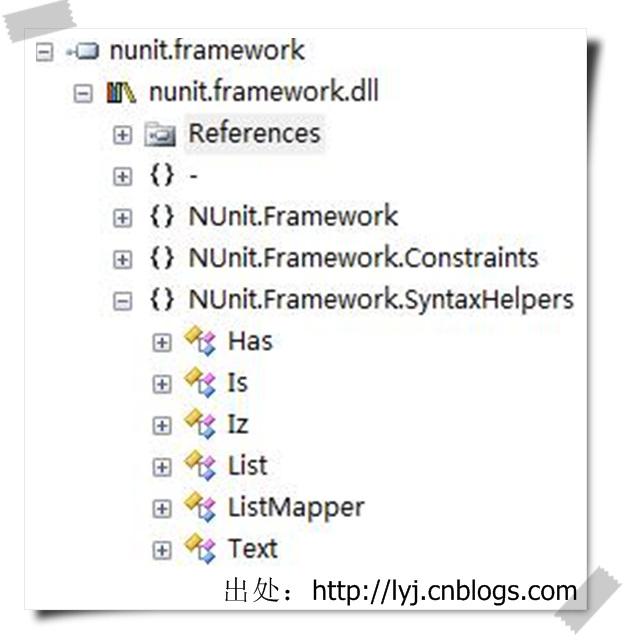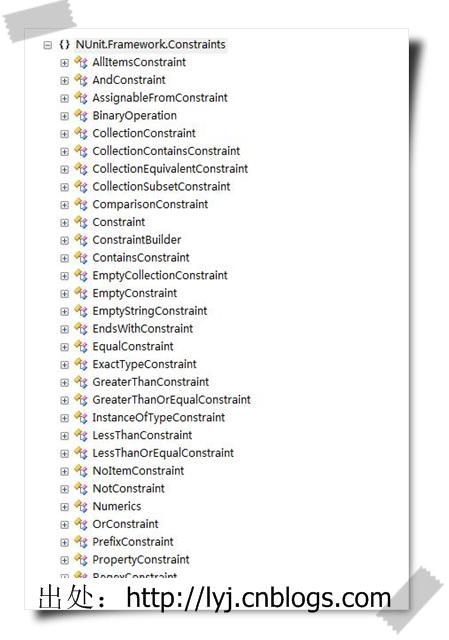前言
这个简短的系列一一讲解一下.Net下测试的相关知识,希望对初学者有所帮助。
在这个系列第一篇中从测试工具入手推荐TestDriven.NET。官方下载TestDriven.NET-2.14.2190 Beta版(直接下载)和TestDriven.NET-2.13.2184正式版(直接下载)。第二篇中我选择了最为经典的NUnit单元测试框架来介绍TestDriven.NET所支持的一些重要的属性。这一篇继续使用这个框架,介绍单元测试的核心——断言Assert。
概述
在测试框架中,断言是单元测试的核心,我们在测试中要对其程序断言,如果某个断言失败,方法的调用不会返回值,并且会报告一个错误。如果一个测试包含多个断言,那些紧跟失败断言的那些断言都不会执行,因此每个测试方法最好只有一个断言。
下面看看NUnit框架吧,来2张图:
断言
现在,我们使用经典的NUnit框架的最新版本,可以用三种方法来写我们的断言:
- 标准模式:过去比较经典的写法。这些方法在NUnit.Framework命名空间下的Assert类中以静态方法提供,对其不同的类型(字符串、集合、文件)NUnit.Framework框架还提供了字符串断言、集合断言、文件断言。
- 约束模式:全新的写法,使用Assert.That()方法来约束扩展所有的断言,使用新增NUnit.Framework.SyntaxHelpers命名空间下提供的方法调用NUnit.Framework.Constraints命名空间下的各种约束。
- 继承模式:只要把测试的类继承NUnit.Framework.AssertionHelper类,可以使用Expect()方法来替换Assert.That()方法。
在这里,我把Assert方法分为:同等断言、一致性断言、比较断言、类型断言、条件测试、工具方法这6类,另外还有字符串断言、集合断言、文件断言。
当然按照约束方式,也可以大致分为Equal Constraint、Same As Constraint、Condition Constraints、Comparison Constraints、Type Constraints、String Constraints、Collection Constraints、Property Constraint、Compound Constraints、Custom Constraints、List Mapper等。
下面我依次介绍一下断言,使用三种方式来写自己的断言。
- Equality Asserts(同等断言)
- Identity Asserts(一致性断言)
- Comparison Asserts(比较断言)
- Type Asserts(类型断言)
- Condition tests(条件测试)
- Utility methods(工具方法)
- StringAssert(字符串断言)
- CollectionAssert(集合断言)
- FileAssert(文件断言)
- 其他约束
1.Equality Asserts、Equal Constraint
NUnit.Framework提供了Assert.AreEqual()、Assert.AreNotEqual()方法测试两个对象是否相等。方法支持相同类型,不同类型,多维数组,嵌套数组,集合类相互比较。
NUnit.Framework.AssertionHelper命名空间下提供了Is.EqualTo(object)方法使用同等约束条件来测试两个对象是否相等。当然了,我们继承NUnit.Framework.AssertionHelper类,可以使用Expect()方法来替换Assert.That()方法。下面给出这个例子:
注意:需要引用NUnit.Framework,NUnit.Framework.AssertionHelper,NUnit.Framework.Constraints命名空间,并把测试类继承AssertionHelper。
[Test] public void EqualTest() { //定义一些变量 var i3 = new int[] { 1, 2, 3 }; var d3 = new double[] { 1.0, 2.0, 3.0 }; var iunequal = new int[] { 1, 3, 2 }; var array2x2 = new int[,] { { 1, 2 }, { 3, 4 } }; var array4 = new int[] { 1, 2, 3, 4 }; var actual = new string[] { "HELLO", "world" }; var expected = new string[] { "Hello", "World" }; //经典语法 Assert.AreEqual(4, 2 + 2); Assert.AreEqual(i3, d3); Assert.AreNotEqual(5, 2 + 2); Assert.AreNotEqual(i3, iunequal); //约束语法 Assert.That(2 + 2, Is.EqualTo(4)); Assert.That(2 + 2 == 4); Assert.That(2 + 2, Is.Not.EqualTo(5)); Assert.That(2 + 2 != 5); Assert.That(5.0, Is.EqualTo(5)); Assert.That(2.1 + 1.2, Is.EqualTo(3.3).Within(.0005)); Assert.That(double.PositiveInfinity, Is.EqualTo(double.PositiveInfinity)); Assert.That(double.NaN, Is.EqualTo(double.NaN)); Assert.That(i3, Is.EqualTo(d3)); Assert.That(i3, Is.Not.EqualTo(iunequal)); Assert.That(array2x2, Is.EqualTo(array4).AsCollection); //成功 Assert.That("Hello!", Is.EqualTo("HELLO!").IgnoreCase); Assert.That(actual, Is.EqualTo(expected).IgnoreCase); //使用继承语法 Expect(2 + 2, EqualTo(4)); Expect(2 + 2 == 4); Expect(i3, EqualTo(d3)); Expect(2 + 2, Not.EqualTo(5)); Expect(i3, Not.EqualTo(iunequal)); }
2.Identity Asserts、Same As Constraint
Assert.AreSame()和Assert.AreNotSame()方法测试两个对象是否是同一个对象。Assert.Contains方法用来测试在一个数组或列表里是否包含该对象。
NUnit.Framework.AssertionHelper命名空间下提供了Is.SameAs(object)方法使用Same As约束条件来测试两个对象是否是相同对象。使用继承也是如此。
[Test] public void SameAsTest() { //定义变量 var ex1 = new Exception(); var ex2 = ex1; var ex3 = new Exception(); //约束语法 Assert.That(ex2, Is.SameAs(ex1)); Assert.That(ex3, Is.Not.SameAs(ex1)); //使用继承语法 Expect(ex2, SameAs(ex1)); Expect(ex3, Not.SameAs(ex1)); }
3.Comparison Asserts、Comparison Constraints
NUnit.Framework框架为我们提供了下面四个方法:
- Assert.Greater(x, y)方法用于测试一个对象是否大于另外一个对象。
- Assert.GreaterOrEqual(x, y)方法用于测试一个对象是否大于等于另外一个对象。
- Assert.Less(x, y)方法用于测试一个对象是否小于另外一个对象。
- Assert.LessOrEqual(x, y)方法用于测试一个对象是否小于等于另外一个对象。
NUnit.Framework.AssertionHelper命名空间下提供了Is.GreaterThan(IComparable)、Is.GreaterThanOrEqualTo(IComparable)、Is.AtLeast(IComparable)、 Is.LessThan(IComparable)、Is.LessThanOrEqualTo(IComparable)、Is.AtMost(IComparable)方法使用比较约束条件来测试比较两个对象。使用继承也是如此。
[Test] public void ComparisonTest() { //经典语法 Assert.Greater(7, 3); Assert.GreaterOrEqual(7, 3); Assert.GreaterOrEqual(7, 7); Assert.Less(3, 7); Assert.LessOrEqual(3, 7); Assert.LessOrEqual(3, 3); //约束语法 Assert.That(7, Is.GreaterThan(3)); Assert.That(7, Is.GreaterThanOrEqualTo(3)); Assert.That(7, Is.AtLeast(3)); Assert.That(7, Is.GreaterThanOrEqualTo(7)); Assert.That(7, Is.AtLeast(7)); Assert.That(3, Is.LessThan(7)); Assert.That(3, Is.LessThanOrEqualTo(7)); Assert.That(3, Is.AtMost(7)); Assert.That(3, Is.LessThanOrEqualTo(3)); Assert.That(3, Is.AtMost(3)); //使用继承语法 Expect(7, GreaterThan(3)); Expect(7, GreaterThanOrEqualTo(3)); Expect(7, AtLeast(3)); Expect(7, GreaterThanOrEqualTo(7)); Expect(7, AtLeast(7)); Expect(3, LessThan(7)); Expect(3, LessThanOrEqualTo(7)); Expect(3, AtMost(7)); Expect(3, LessThanOrEqualTo(3)); Expect(3, AtMost(3)); }
4.Type Asserts、Type Constraints
Assert.IsAssignableFrom(),Assert.IsNotAssignableFrom(),Assert.IsInstanceOfType(),Assert.IsNotInstanceOfType()方法让我们可以构造一些关于对象类型的断言。
同理,NUnit.Framework.AssertionHelper命名空间下提供了Is.TypeOf(Type)、Is.InstanceOfType(Type)、Is.AssignableFrom(Type)方法使用类型约束条件来测试对象类型。使用继承也是如此。
[Test] public void TypeTest() { //经典语法 Assert.AreEqual(typeof(string), "Hello".GetType()); Assert.AreEqual("System.String", "Hello".GetType().FullName); Assert.AreNotEqual(typeof(int), "Hello".GetType()); Assert.AreNotEqual("System.Int32", "Hello".GetType().FullName); Assert.IsInstanceOfType(typeof(string), "Hello"); Assert.IsNotInstanceOfType(typeof(string), 5); Assert.IsAssignableFrom(typeof(string), "Hello"); Assert.IsNotAssignableFrom(typeof(string), 5); //约束语法 Assert.That("Hello", Is.TypeOf(typeof(string))); Assert.That("Hello", Is.Not.TypeOf(typeof(int))); Assert.That("Hello", Is.InstanceOfType(typeof(string))); Assert.That(5, Is.Not.InstanceOfType(typeof(string))); Assert.That("Hello", Is.AssignableFrom(typeof(string))); Assert.That(5, Is.Not.AssignableFrom(typeof(string))); //使用继承语法 Expect("Hello", TypeOf(typeof(string))); Expect("Hello", Not.TypeOf(typeof(int))); Expect("Hello", InstanceOfType(typeof(string))); Expect(5, Not.InstanceOfType(typeof(string))); Expect("Hello", AssignableFrom(typeof(string))); Expect(5, Not.AssignableFrom(typeof(string))); }
5.Condition Tests、Condition Constraints
测试框架提供了Assert.IsTrue,Assert.IsFalse,Assert.IsNaN,Assert.IsEmpty、Assert.IsNotEmpty,Assert.IsNull、Assert.IsNotNull方法分别用于测试两个对象是否正确,错误,非数字,(字符串或集合)空、非空,引用为空、引用不为空。
而NUnit.Framework.AssertionHelper命名空间也提供相类似的方法使用条件约束测试对象。直接看例子:
[Test] public void ConditionTest() { //定义变量 double d = double.NaN; //经典语法 Assert.IsNull(null); Assert.IsNotNull(42); Assert.IsTrue(2 + 2 == 4); Assert.IsFalse(2 + 2 == 5); Assert.IsNaN(d); Assert.IsEmpty(""); Assert.IsNotEmpty("Hello!"); Assert.IsEmpty(new bool[0]); Assert.IsNotEmpty(new int[] { 1, 2, 3 }); //约束语法 Assert.That(null, Is.Null); Assert.That(42, Is.Not.Null); Assert.That(2 + 2 == 4, Is.True); Assert.That(2 + 2 == 4); Assert.That(2 + 2 == 5, Is.False); Assert.That(d, Is.NaN); Assert.That("", Is.Empty); Assert.That("Hello!", Is.Not.Empty); Assert.That(new bool[0], Is.Empty); Assert.That(new int[] { 1, 2, 3 }, Is.Not.Empty); //使用继承语法 Expect(null, Null); Expect(42, Not.Null); Expect(2 + 2 == 4, True); Expect(2 + 2 == 4); Expect(2 + 2 == 5, False); Expect(d, NaN); Expect("", Empty); Expect("Hello!", Not.Empty); Expect(new bool[0], Empty); Expect(new int[] { 1, 2, 3 }, Not.Empty); }
6.Utility methods
我们想对测试有自定义控制,测试框架提供了两个实用方法:Assert.Fail()和Assert.Ignore()方法。这对于开发你自己的特定项目的断言,例如用于判断中它非常有用。
Assert.Fail()方法表示这个测试方法是一个失败方法,这个失败是基于其他方法没有封装的测试。
Assert.Ignore()方法表示这个测试方法是一个忽略的方法,在测试过程中,将忽略这个测试。
7.StringAssert、String Constraints
StringAssert类提供许多AreEqualIgnoringCase、Contains、StartsWith、EndsWith、IsMatch、Equals、ReferenceEquals方法,这些方法在检查字符串值时是有用的。
而NUnit.Framework.AssertionHelper命名空间也提供相类似的Text.Contains(string)、Text.DoesNotContain(string)、Text.StartsWith(string)、Text.DoesNotStartWith(string)、Text.EndsWith(string)、Text.DoesNotEndWith(string)、Text.Matches(string)、Text.DoesNotMatch(string) 方法使用字符串约束检查字符串。直接看例子:
[Test] public void StringTest() { //定义变量 var phrase = "Hello World!"; var array = new string[] { "abc", "bad", "dba" }; var greetings = new string[] { "Hello!", "Hi!", "Hola!" }; var passage = "Now is the time for all good men to come to the aid of their country."; var quotes = new string[] { "Never say never", "It's never too late", "Nevermore!" }; //经典语法 StringAssert.Contains("World", phrase); StringAssert.StartsWith("Hello", phrase); StringAssert.EndsWith("!", phrase); StringAssert.AreEqualIgnoringCase("hello world!", phrase); StringAssert.IsMatch("all good men", passage); StringAssert.IsMatch("Now.*come", passage); //约束语法 //测试是否包含"World" Assert.That(phrase, Text.Contains("World")); Assert.That(phrase, Text.DoesNotContain("goodbye")); Assert.That(phrase, Text.Contains("WORLD").IgnoreCase); Assert.That(phrase, Text.DoesNotContain("BYE").IgnoreCase); Assert.That(array, Text.All.Contains("b")); //测试字符串是否以"Hello"开始 Assert.That(phrase, Text.StartsWith("Hello")); Assert.That(phrase, Text.DoesNotStartWith("Hi!")); Assert.That(phrase, Text.StartsWith("HeLLo").IgnoreCase); Assert.That(phrase, Text.DoesNotStartWith("HI").IgnoreCase); Assert.That(greetings, Text.All.StartsWith("h").IgnoreCase); //测试字符串是否以"!"结束 Assert.That(phrase, Text.EndsWith("!")); Assert.That(phrase, Text.DoesNotEndWith("?")); Assert.That(phrase, Text.EndsWith("WORLD!").IgnoreCase); Assert.That(greetings, Text.All.EndsWith("!")); Assert.That(phrase, Is.EqualTo("hello world!").IgnoreCase); Assert.That(phrase, Is.Not.EqualTo("goodbye world!").IgnoreCase); Assert.That(new string[] { "Hello", "World" }, Is.EqualTo(new object[] { "HELLO", "WORLD" }).IgnoreCase); Assert.That(new string[] { "HELLO", "Hello", "hello" }, Is.All.EqualTo("hello").IgnoreCase); //测试字符串是否同"all good men"相配 Assert.That(passage, Text.Matches("all good men")); Assert.That(passage, Text.Matches("Now.*come")); Assert.That(passage, Text.DoesNotMatch("all.*men.*good")); Assert.That(passage, Text.Matches("ALL").IgnoreCase); Assert.That(quotes, Text.All.Matches("never").IgnoreCase); //使用继承语法 //测试是否包含"World" Expect(phrase, Contains("World")); Expect(phrase, Not.Contains("goodbye")); Expect(phrase, Contains("WORLD").IgnoreCase); Expect(phrase, Not.Contains("BYE").IgnoreCase); Expect(array, All.Contains("b")); //测试字符串是否以"Hello"开始 Expect(phrase, StartsWith("Hello")); Expect(phrase, Not.StartsWith("Hi!")); Expect(phrase, StartsWith("HeLLo").IgnoreCase); Expect(phrase, Not.StartsWith("HI").IgnoreCase); Expect(greetings, All.StartsWith("h").IgnoreCase); //测试字符串是否以"!"结束 Expect(phrase, EndsWith("!")); Expect(phrase, Not.EndsWith("?")); Expect(phrase, EndsWith("WORLD!").IgnoreCase); Expect(greetings, All.EndsWith("!")); Expect(phrase, EqualTo("hello world!").IgnoreCase); Expect(phrase, Not.EqualTo("goodbye world!").IgnoreCase); Expect(new string[] { "Hello", "World" }, EqualTo(new object[] { "HELLO", "WORLD" }).IgnoreCase); Expect(new string[] { "HELLO", "Hello", "hello" }, All.EqualTo("hello").IgnoreCase); //测试字符串是否同"all good men"相配 Expect(passage, Matches("all good men")); Expect(passage, Matches("Now.*come")); Expect(passage, Not.Matches("all.*men.*good")); Expect(passage, Matches("ALL").IgnoreCase); Expect(quotes, All.Matches("never").IgnoreCase); }
8.CollectionAssert、Collection Constraints
CollectionAssert类提供许多方法,像AllItemsAreInstancesOfType、AllItemsAreNotNull、AllItemsAreUnique、AreEqual(相同对象和次序)、AreEquivalent(相同对象次序不同)、AreNotEqual、AreNotEquivalent、Contains、DoesNotContain、IsEmpty、IsNotEmpty、IsNotSubsetOf、IsSubsetOf、ReferenceEquals。这些方法在检查集合值和比较两个集合时是有用的。集合参数必须实现IEnumerable接口。
而NUnit.Framework.AssertionHelper命名空间也提供相类似的方法使用集合约束检查集合。下面用例子说明,一看就明白。
[Test] public void AllItemsTests() { //定义3个集合 object[] ints = new object[] { 1, 2, 3, 4 }; object[] doubles = new object[] { 0.99, 2.1, 3.0, 4.05 }; object[] strings = new object[] { "abc", "bad", "cab", "bad", "dad" }; //经典语法 CollectionAssert.AllItemsAreNotNull(ints);//ints集合所有项不为空 CollectionAssert.AllItemsAreInstancesOfType(ints, typeof(int));//ints集合所有项类型为int CollectionAssert.AllItemsAreInstancesOfType(strings, typeof(string)); CollectionAssert.AllItemsAreUnique(ints);//ints集合所有项都是唯一的 //Helper语法 Assert.That(ints, Is.All.Not.Null); Assert.That(ints, Has.None.Null); Assert.That(ints, Is.All.InstanceOfType(typeof(int))); Assert.That(ints, Has.All.InstanceOfType(typeof(int))); Assert.That(strings, Is.All.InstanceOfType(typeof(string))); Assert.That(strings, Has.All.InstanceOfType(typeof(string))); Assert.That(ints, Is.Unique); Assert.That(strings, Is.Not.Unique); Assert.That(ints, Is.All.GreaterThan(0)); Assert.That(ints, Has.All.GreaterThan(0)); Assert.That(ints, Has.None.LessThanOrEqualTo(0)); Assert.That(strings, Text.All.Contains("a")); Assert.That(strings, Has.All.Contains("a")); Assert.That(strings, Has.Some.StartsWith("ba")); Assert.That(strings, Has.Some.Property("Length", 3)); Assert.That(strings, Has.Some.StartsWith("BA").IgnoreCase); Assert.That(doubles, Has.Some.EqualTo(1.0).Within(.05)); //使用继承语法 Expect(ints, All.Not.Null); Expect(ints, None.Null); Expect(ints, All.InstanceOfType(typeof(int))); Expect(strings, All.InstanceOfType(typeof(string))); Expect(ints, Unique); Expect(strings, Not.Unique); Expect(ints, All.GreaterThan(0)); Expect(ints, None.LessThanOrEqualTo(0)); Expect(strings, All.Contains("a")); Expect(strings, Some.StartsWith("ba")); Expect(strings, Some.StartsWith("BA").IgnoreCase); Expect(doubles, Some.EqualTo(1.0).Within(.05)); }
9.FileAssert
FileAssert类提供AreEqual、AreNotEqual方法来比较两个文件,文件可以作为Stream、FileInfo、指定的文件路径来操作。
10.其他约束
这些约束都是新增的,由于和经典的断言没有一致的分类,我把它们单独列出来了,也在这里说说。
10-1.Property Constraint
属性约束。由主要测试对象的属性。
[Test] public void PropertyTest() { //定义变量 string[] array = { "abc", "bca", "xyz", "qrs" }; string[] array2 = { "a", "ab", "abc" }; ArrayList list = new ArrayList(array); //约束语法 Assert.That(list, Has.Property("Count"));//是否有Count属性 Assert.That(list, Has.No.Property("Length"));//是否没有Length属性 Assert.That("Hello", Has.Property("Length", 5));//"Hello"的Length属性是否是5 Assert.That("Hello", Has.Length(5));//"Hello"的Length属性是否是5 Assert.That("Hello", Has.Property("Length").EqualTo(5));//"Hello"的Length属性是否是5 Assert.That("Hello", Has.Property("Length").GreaterThan(3));//"Hello"的Length属性是否大于3 Assert.That(array, Has.Property("Length", 4)); Assert.That(array, Has.Length(4)); Assert.That(array, Has.Property("Length").LessThan(10)); Assert.That(array, Has.All.Property("Length", 3));//所有项Length属性是否是3 Assert.That(array, Has.All.Length(3)); Assert.That(array, Is.All.Length(3)); Assert.That(array, Has.All.Property("Length").EqualTo(3)); Assert.That(array, Is.All.Property("Length").EqualTo(3)); Assert.That(array2, Has.Some.Property("Length", 2)); Assert.That(array2, Has.Some.Length(2)); Assert.That(array2, Has.Some.Property("Length").GreaterThan(2)); Assert.That(array2, Is.Not.Property("Length", 4)); Assert.That(array2, Is.Not.Length(4)); Assert.That(array2, Has.No.Property("Length").GreaterThan(3)); Assert.That(List.Map(array2).Property("Length"), Is.EqualTo(new int[] { 1, 2, 3 })); Assert.That(List.Map(array2).Property("Length"), Is.EquivalentTo(new int[] { 3, 2, 1 })); Assert.That(List.Map(array2).Property("Length"), Is.SubsetOf(new int[] { 1, 2, 3, 4, 5 })); Assert.That(List.Map(array2).Property("Length"), Is.Unique); Assert.That(list, Has.Count(4)); //继承语法 Expect(list, Property("Count")); Expect(list, Not.Property("Nada")); Expect("Hello", Property("Length", 5)); Expect("Hello", Length(5)); Expect("Hello", Property("Length").EqualTo(5)); Expect("Hello", Property("Length").GreaterThan(0)); Expect(array, Property("Length", 4)); Expect(array, Length(4)); Expect(array, Property("Length").LessThan(10)); Expect(array, All.Property("Length", 3)); Expect(array, All.Length(3)); Expect(array, All.Property("Length").EqualTo(3)); Expect(array2, Some.Property("Length", 2)); Expect(array2, Some.Length(2)); Expect(array2, Some.Property("Length").GreaterThan(2)); Expect(array2, None.Property("Length", 4)); Expect(array2, None.Length(4)); Expect(array2, None.Property("Length").GreaterThan(3)); Expect(Map(array2).Property("Length"), EqualTo(new int[] { 1, 2, 3 })); Expect(Map(array2).Property("Length"), EquivalentTo(new int[] { 3, 2, 1 })); Expect(Map(array2).Property("Length"), SubsetOf(new int[] { 1, 2, 3, 4, 5 })); Expect(Map(array2).Property("Length"), Unique); Expect(list, Count(4)); }
10-2.Compound Constraints
进行对象间的比较。由几个方法复合作用。
[Test] public void CompoundTest() { //约束语法 Assert.That(2 + 2, Is.Not.EqualTo(5)); Assert.That(new int[] { 1, 2, 3 }, Is.All.GreaterThan(0)); Assert.That(2.3, Is.GreaterThan(2.0) & Is.LessThan(3.0)); Assert.That(3, Is.LessThan(5) | Is.GreaterThan(10)); //继承语法 Expect(2 + 2, Not.EqualTo(5)); Expect(2.3, GreaterThan(2.0) & LessThan(3.0)); }
10-3.List Mapper
集合映射,比如下面的例子,测试strings数组对应项的Length属性是否为lengths对应项的值。
[Test] public void ListMapperTest() { //定义2个数组 string[] strings = new string[] { "a", "ab", "abc" }; int[] lengths = new int[] { 1, 2, 3 }; //约束语法 Assert.That(List.Map(strings).Property("Length"), Is.EqualTo(lengths)); Assert.That(new ListMapper(strings).Property("Length"), Is.EqualTo(lengths)); //继承语法 Expect(Map(strings).Property("Length"), EqualTo(lengths)); }
结束语
关于这篇测试语法断言介绍,由于断言很多,很难在一篇文章中把所有的断言学习到。之前,我也想考虑分为经典模式和约束模式来介绍,发现大致相同,也浪费大量时间,所以千思万想,把这些属性整合在一起综合介绍,带着丰富的例子,相信可以掌握这些断言。考虑到本节代码过多,还有一部分还没有贴出来,提供下载。地址为:YJingLee.Test.zip(VS2008项目,如果你是VS2005只需复制其中的测试文件到你的项目中即可)
这篇就写到这里了,下篇开始学习单元测试。

